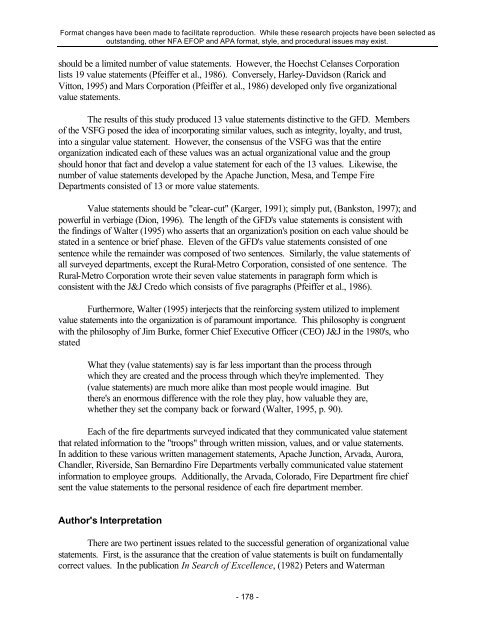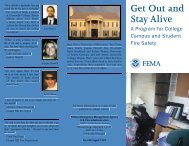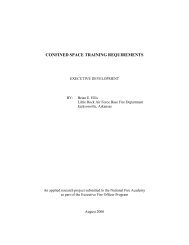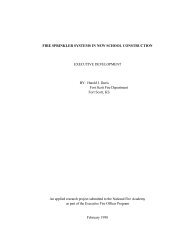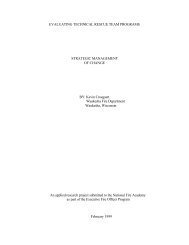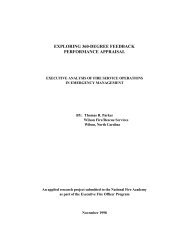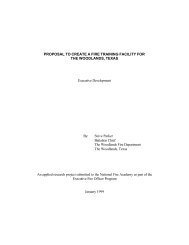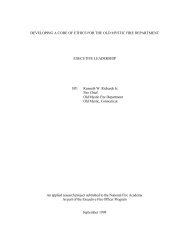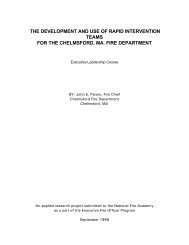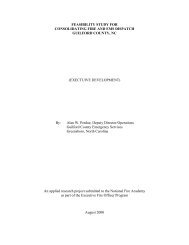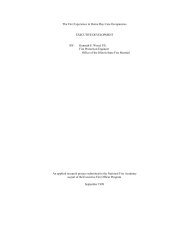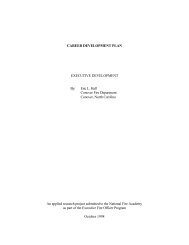Value Statements - US Fire Administration
Value Statements - US Fire Administration
Value Statements - US Fire Administration
Create successful ePaper yourself
Turn your PDF publications into a flip-book with our unique Google optimized e-Paper software.
Format changes have been made to facilitate reproduction. While these research projects have been selected as<br />
outstanding, other NFA EFOP and APA format, style, and procedural issues may exist.<br />
should be a limited number of value statements. However, the Hoechst Celanses Corporation<br />
lists 19 value statements (Pfeiffer et al., 1986). Conversely, Harley-Davidson (Rarick and<br />
Vitton, 1995) and Mars Corporation (Pfeiffer et al., 1986) developed only five organizational<br />
value statements.<br />
The results of this study produced 13 value statements distinctive to the GFD. Members<br />
of the VSFG posed the idea of incorporating similar values, such as integrity, loyalty, and trust,<br />
into a singular value statement. However, the consensus of the VSFG was that the entire<br />
organization indicated each of these values was an actual organizational value and the group<br />
should honor that fact and develop a value statement for each of the 13 values. Likewise, the<br />
number of value statements developed by the Apache Junction, Mesa, and Tempe <strong>Fire</strong><br />
Departments consisted of 13 or more value statements.<br />
<strong>Value</strong> statements should be "clear-cut" (Karger, 1991); simply put, (Bankston, 1997); and<br />
powerful in verbiage (Dion, 1996). The length of the GFD's value statements is consistent with<br />
the findings of Walter (1995) who asserts that an organization's position on each value should be<br />
stated in a sentence or brief phase. Eleven of the GFD's value statements consisted of one<br />
sentence while the remainder was composed of two sentences. Similarly, the value statements of<br />
all surveyed departments, except the Rural-Metro Corporation, consisted of one sentence. The<br />
Rural-Metro Corporation wrote their seven value statements in paragraph form which is<br />
consistent with the J&J Credo which consists of five paragraphs (Pfeiffer et al., 1986).<br />
Furthermore, Walter (1995) interjects that the reinforcing system utilized to implement<br />
value statements into the organization is of paramount importance. This philosophy is congruent<br />
with the philosophy of Jim Burke, former Chief Executive Officer (CEO) J&J in the 1980's, who<br />
stated<br />
What they (value statements) say is far less important than the process through<br />
which they are created and the process through which they're implemented. They<br />
(value statements) are much more alike than most people would imagine. But<br />
there's an enormous difference with the role they play, how valuable they are,<br />
whether they set the company back or forward (Walter, 1995, p. 90).<br />
Each of the fire departments surveyed indicated that they communicated value statement<br />
that related information to the "troops" through written mission, values, and or value statements.<br />
In addition to these various written management statements, Apache Junction, Arvada, Aurora,<br />
Chandler, Riverside, San Bernardino <strong>Fire</strong> Departments verbally communicated value statement<br />
information to employee groups. Additionally, the Arvada, Colorado, <strong>Fire</strong> Department fire chief<br />
sent the value statements to the personal residence of each fire department member.<br />
Author's Interpretation<br />
There are two pertinent issues related to the successful generation of organizational value<br />
statements. First, is the assurance that the creation of value statements is built on fundamentally<br />
correct values. In the publication In Search of Excellence, (1982) Peters and Waterman<br />
- 178 -


